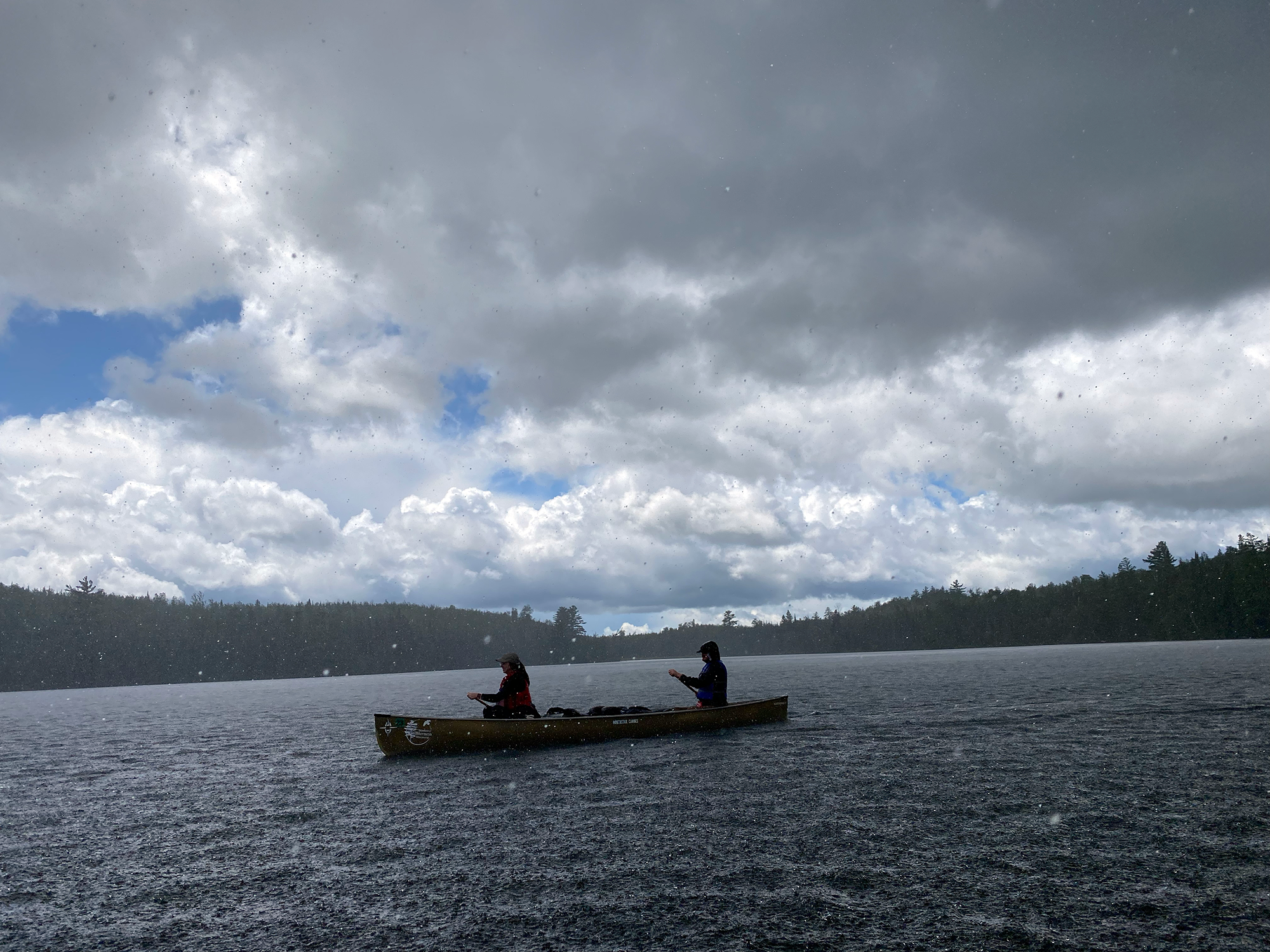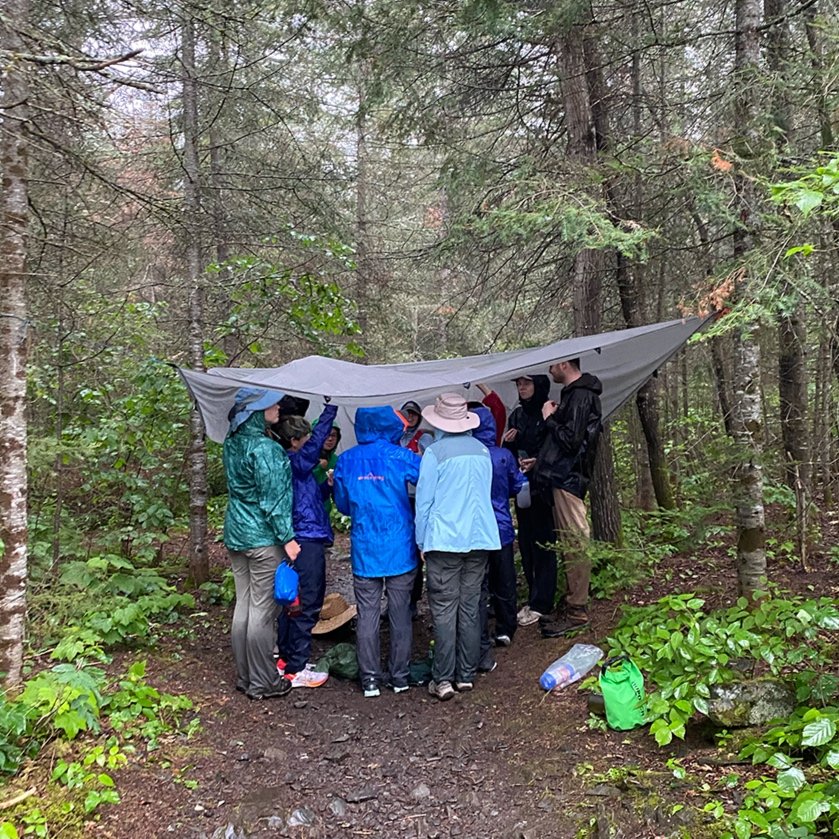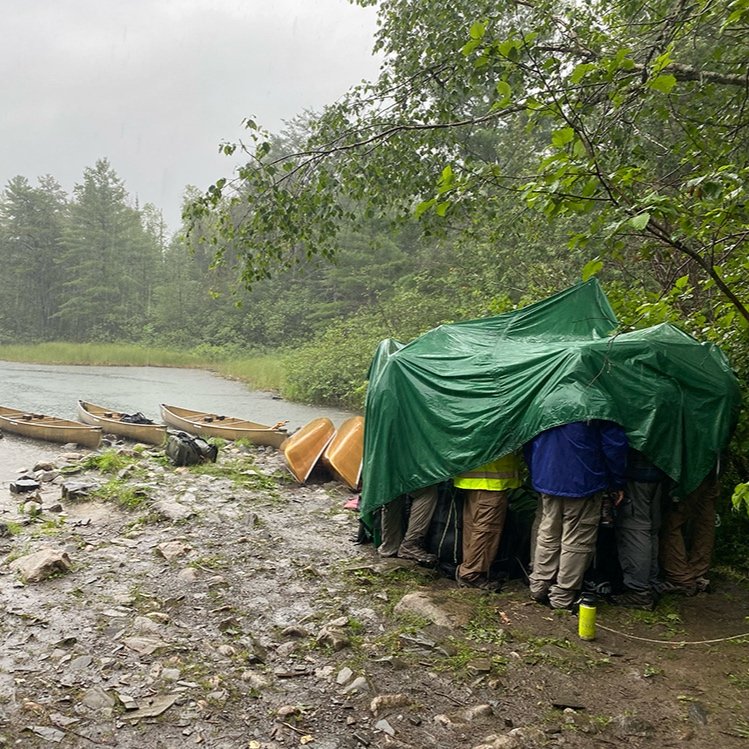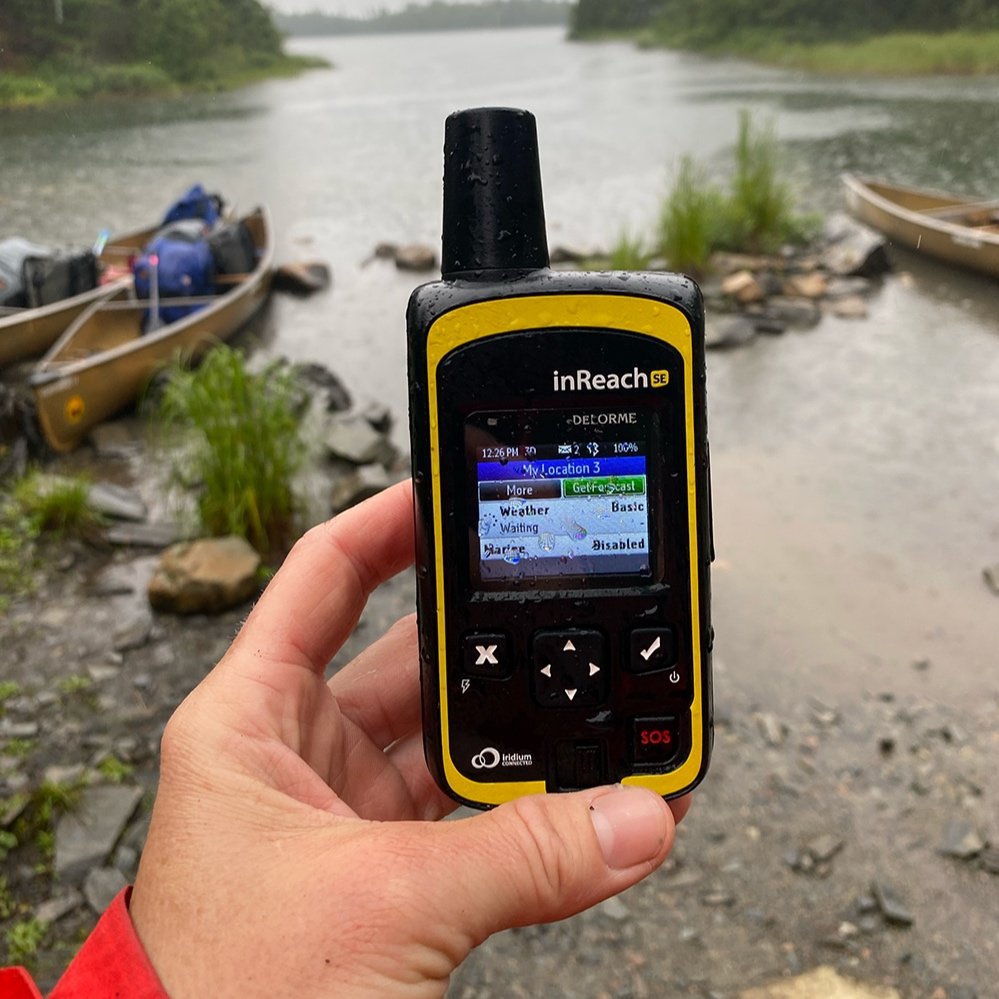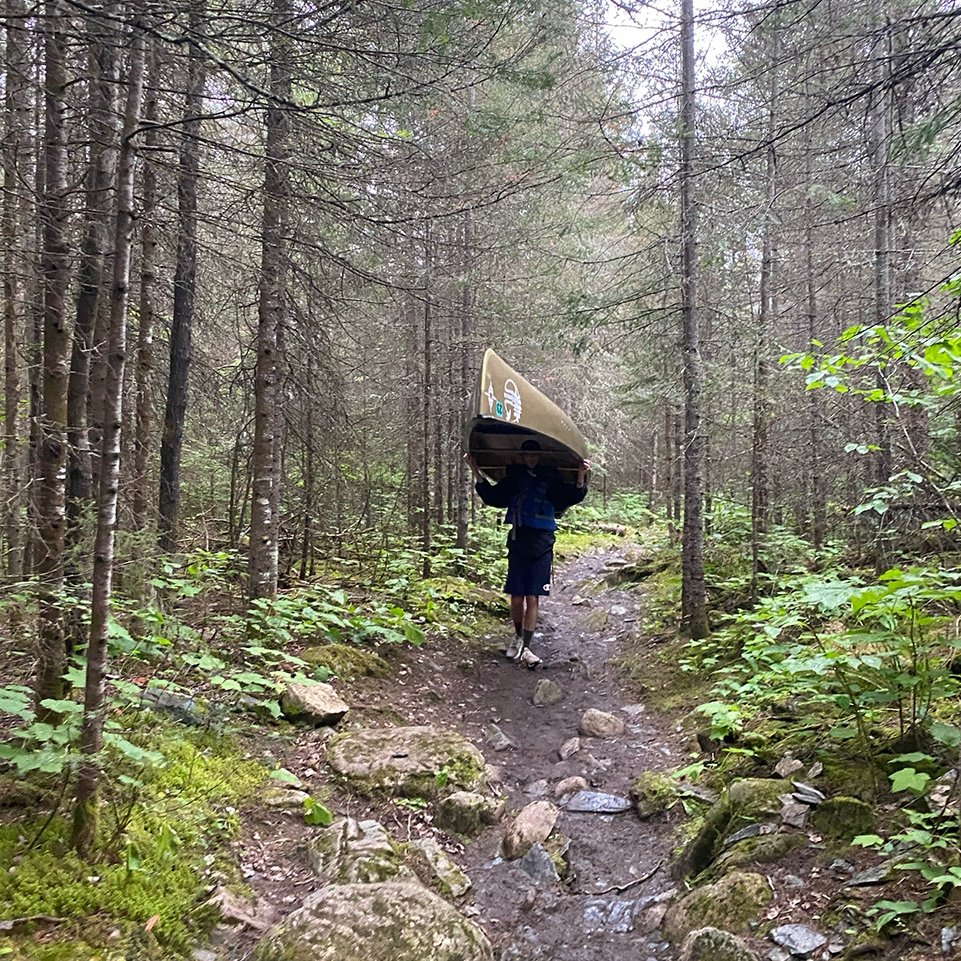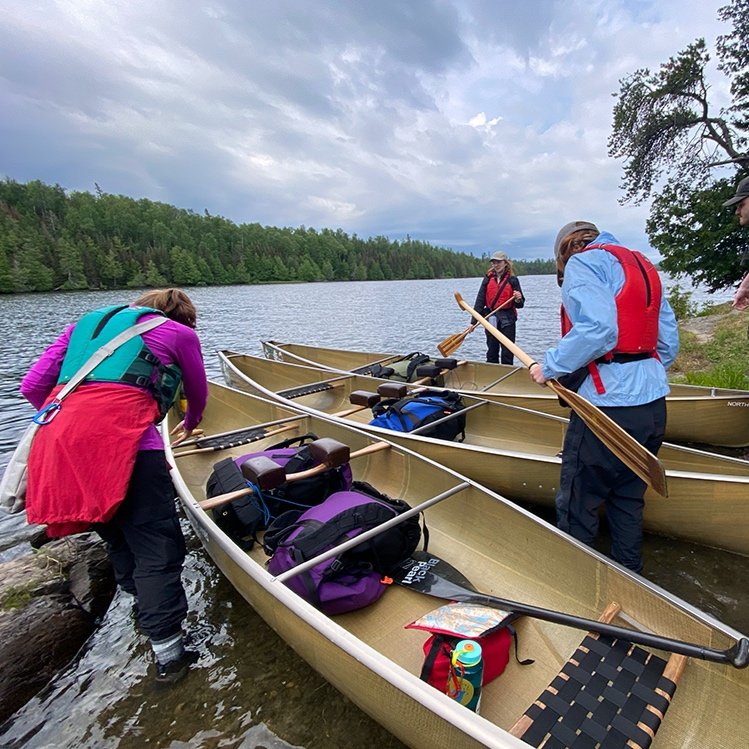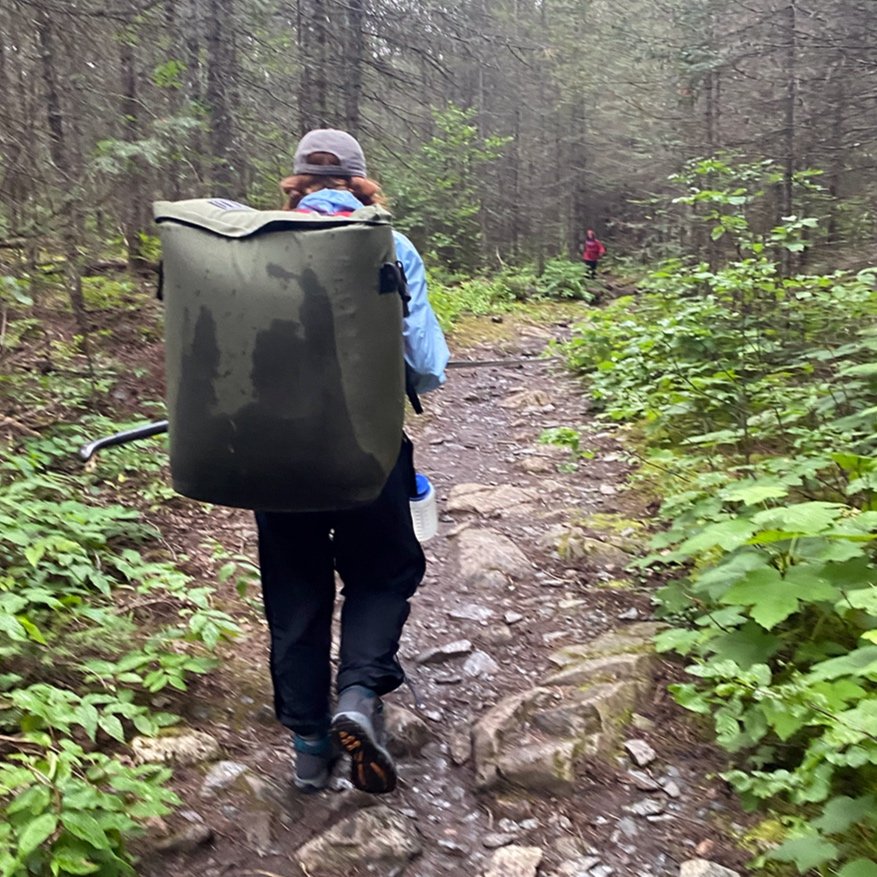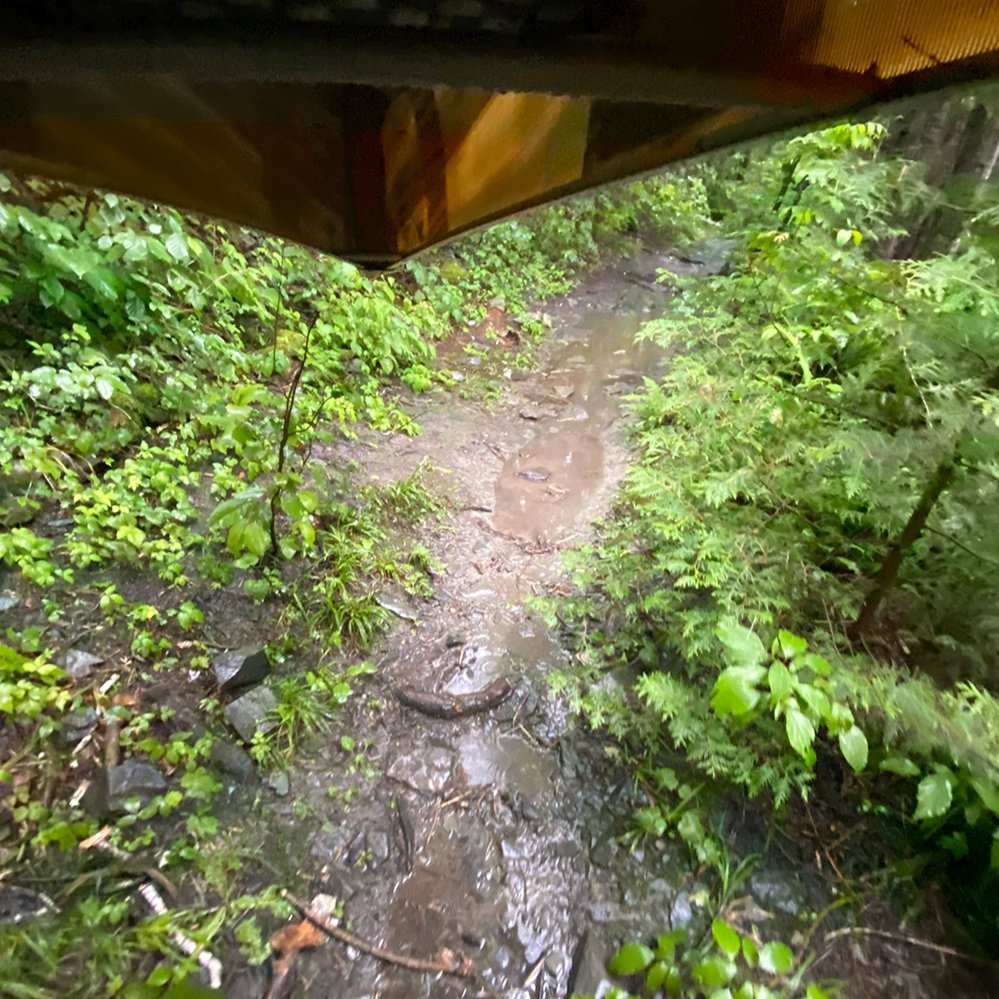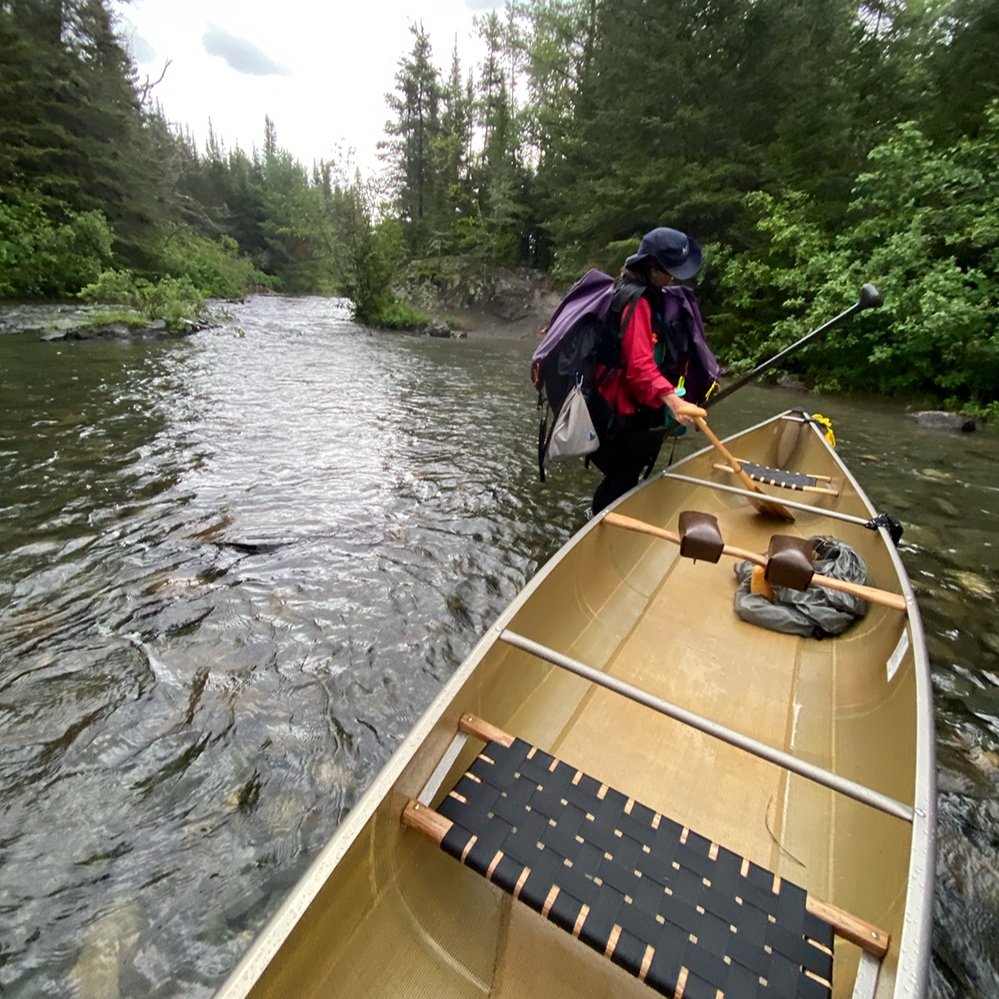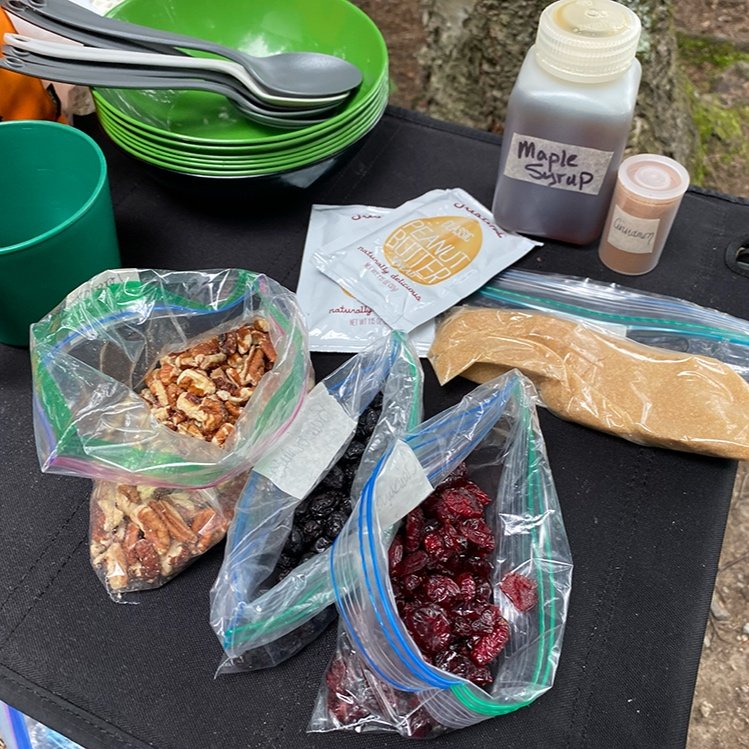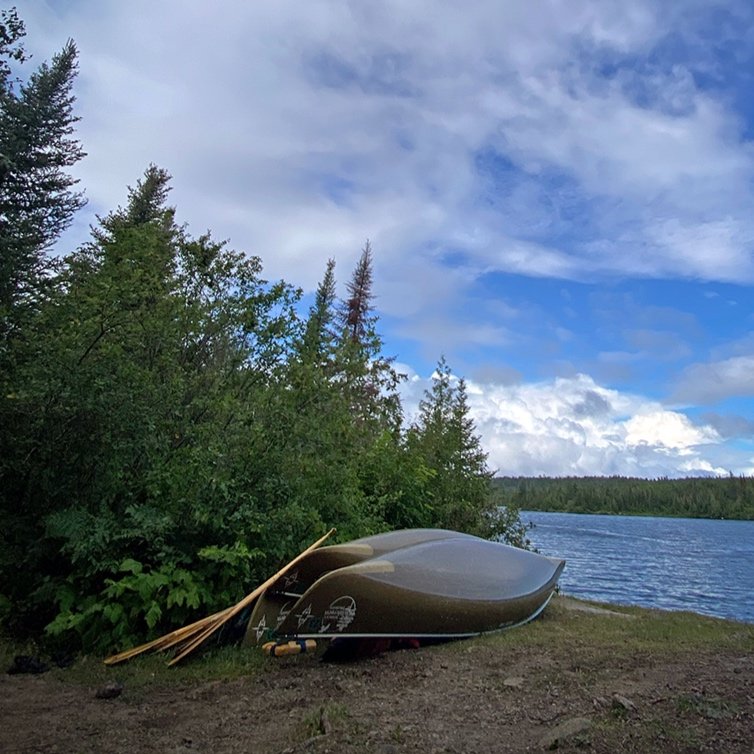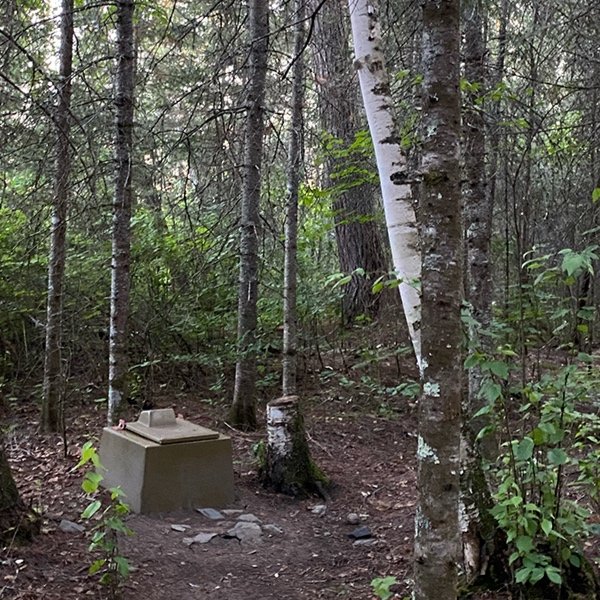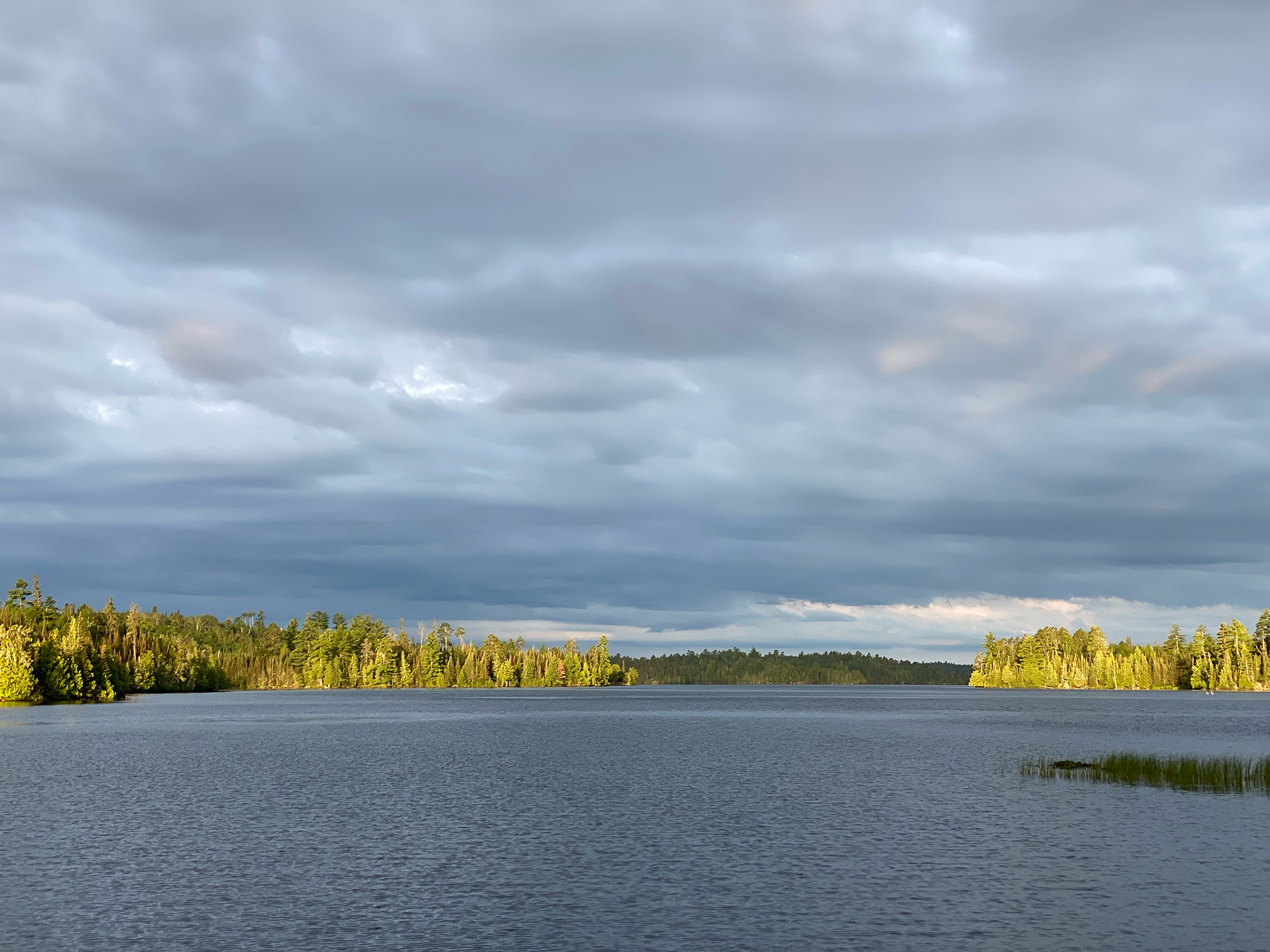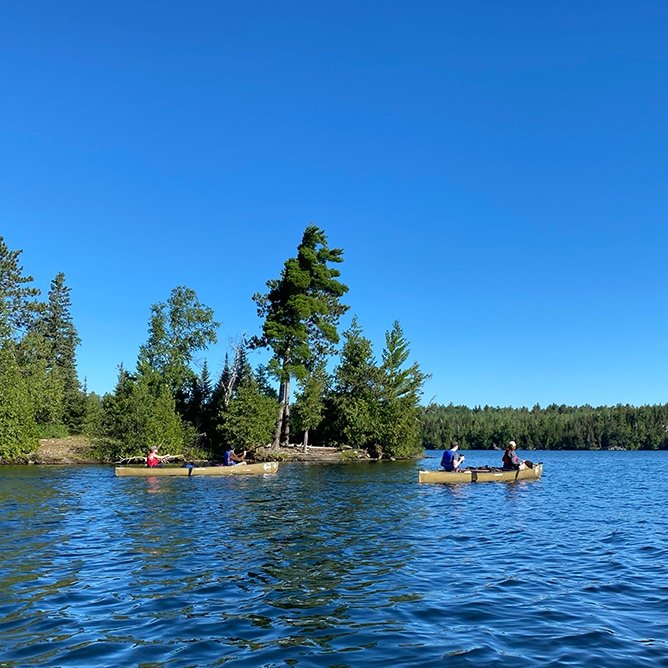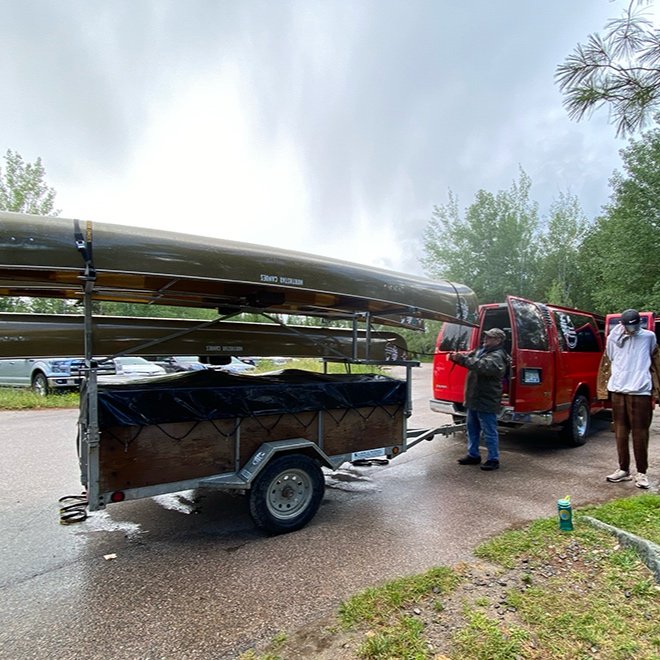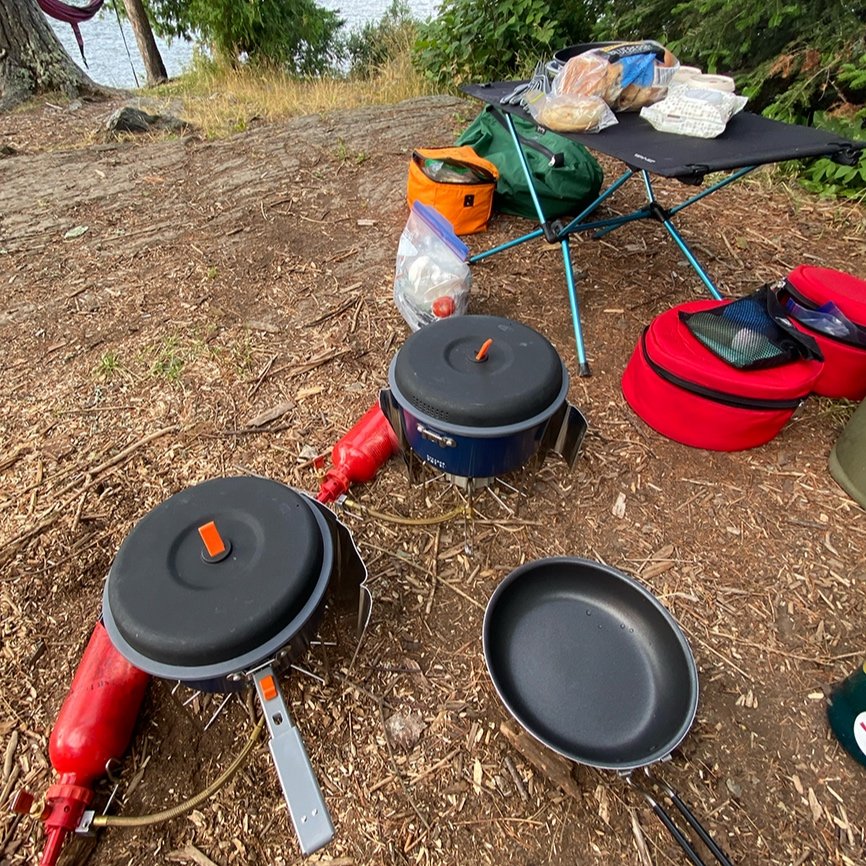BWCA | Sun and Thunder Along the Border
Entry Point: 25 | Moose Lake | Ely, Minnesota
Days on trail: 4
Waterways traveled: Moose Lake, Newfound Lake, Sucker Lake, Birch Lake, Carp Lake,
Knife River and Knife Lake
Portages: 6
Downpour on Moose Lake.
Suddenly the lightening flashed overhead. Nearing the shore, we pushed our paddles deeper into the water, encouraging our canoe forward. Time for a lightening drill and to get off this remote lake in the Boundary Waters Canoe Area (BWCA).
Boats secure, we headed up into the woods, away from tall trees to wait out the storm. Guidelines recommend waiting 30 minutes after the last peel of thunder before proceeding. We watched the rain fall heavy, cloaking the near hillsides in gray.
This was day two of a four day, trip where I guided a group up along the Minnesota and Canadian borders.
Two days prior, we put in at Moose Lake entry point, one of the numerous landings that require a permit to enter the wilderness area. Travel through the BWCA is primarily by canoe, although there are some hiking trails. Moose is a popular entry in the summer and we expected motorized boats for a few miles along with other canoes. We did encounter both but it wasn’t too bad. Most motorized boats tended to give us a wide berth. Some people like to get to the Canadian border quickly and will hire a tow service to skip the first 5 miles of long, Moose Lake.
Before we left the landing, I provided brief instruction on canoeing strokes along with expectations for the day. The prior evening I spent two hours giving an orientation to the group that included what to pack, what to expect as well discussion of their goals and hopes for the adventure. We end the evening with canoe packs packed and a departure time for the next day. This group were mostly new canoeists, but had a little camping experience.
I’m always excited and nervous, but the day shone sunny with a gentle breeze out of the southwest that gave us a great tailwind all day. Roughly five miles in, we paused at a campsite, filled with jackpine and had a snack while shaking out our legs.
Everyone was enjoying the paddle along the gray rocks of the Canadian shield filled with moss and lichen. The boreal forest was alive in birdsong and bugs were few.
A mile or so later we entered into the waters of Birch Lake which straddles the Minnesota and Canadian borders. The countries have an agreement in which border waters are shared (and sometimes the occasional portage trail as well). We paddled along, Quetico Provincial Park, a million acre wilderness to the north and the BWCA, also a million acre wilderness to the south. We were in waters where no motorized boats are allowed. It was wonderfully quiet as the sun filtered through puffy clouds.
As the guide, I had pre-marked some campsites listed as 4-5 star and added other interesting historical notes that I could share with my clients. We paddled closer to what we’d hoped would be our campsite and saw that it was open. I’ve found that it’s best to secure a campsite by 2pm in the summer due to the busy season. The campsite was lovely and faced south/southwest, guaranteeing a lovely sunrise and a brief peek at the sunset. Other campsites were at least a half mile away and so far, vacant.
Bringing up all the canoe packs and canoes up to camp, the others explored the site while I pulled out the food pack and searched for lunch. Color coded bags identify the meals; yellow for breakfast, red for lunch, green for snacks and blue for dinner. Pulling out fresh ham sandwiches and apples, everyone circled back, grabbing food from me before heading down by the water to relax.
While the others enjoyed the sunshine, I set up the kitchen area and grabbed water from the lake to begin filtering through our Platypus system. I walked around and took stock of our campsite. There were 3 pretty decent tent pads with a fourth that could work in a pinch. Decent pads should be flat, have good drainage and be free of debris.
After lunch, everyone grabbed their packs and began to set up their tents with some guidance from me. Once they had set up what would be home for a few days, they scattered - a couple read, one swam and another ended up relaxing in the hammock. I spent time setting up my own one person tent. Later, I spent some time walking a ways back in the woods, looking for dead or down wood to collect for multiple campfires. I sawed and hauled out numerous small spruce trees and some birch logs.
The evening glowed in soft pinks and purples. A steady breeze kept the mosquitoes at bay. Someone spotted a loon family in our bay and throughout the evening they serenaded us with their haunting songs. Flames licked above the fire grate as we watched the evening cast its blanket over the lake. Stars started to flicker. The others set their alarm and got up in the middle of the night to see a bow full of stars - some shooting along with a few satellites. They chatted about how amazing it was in the morning.
DAY TRIP TO ISLE OF PINES
As the day dawned sunny, I got up and enjoyed a little quiet time by the lake, watching the gentle fog burn off. The loons quietly swam in the morning light. One pause to dive and come up with a small fish in its beak. It cooed and fed its loonlet.
Around 7am, I started water for coffee. The others began to slowly stir. While the water was heating I made scrambled eggs with veggies and put out some bagels and cream cheese. Everyone feasted knowing we’d be doing a full-day trip east along the Knife river system. There was a chance of rain and thunderstorms and so we prepared by packing our raingear.
While the group readied the boats, I packed a lunch, more snacks and other gear that would help us stay comfortable and safe with the potential weather.
Passing through the rest of Birch lake we neared the Carp portage. A canoe with two clearly experienced paddlers came towards us. Pulling alongside and offering a Minnesota halloooo, the park rangers introduced themselves and asked to see our permit. After returning the permit to us they asked about the condition of our campsite and if we had any questions or feedback for them. They were ending a two week stint in the BW. I was happy to see them as they’re the first rangers I’ve seen in 22 years of paddling in the wilderness.
We moved slowly through the next 5 portages. They were easy, but busy with groups moving back and forth.. Canoe country etiquette dictates that paddlers to wait in the water vs congregating in large groups at portage landings. So…we wait and chat and take turns.
Across the first easy portage, we set the canoes in the water. Thunder begins to rumble. The clouds had been building but hadn’t looked particularly threatening. However within minutes begins to rain in earnest so I grab the tarp I keep at the top of the pack for this purpose and tell our group to head back in the woods where the rain will be lighter. Plus, it will be safer in the event of lightning. A male scout group hangs out in the open, by the landing, draped in a green tarp. Another female scout group stands in the rain, getting drenched so I invite them to come back by our group where I’ve done a quick hang of our tarp right in the middle of the portage trail.
The group, from California, is full of teen girls thrilled to get out of the rain and chat with new faces. They help hold up the loose sides and share with us that they’re hoping to cover 100 miles. Pretty impressive and we wish them well.
After the rain moves on, we move forward, connecting short portage trails, river like areas and small ponds of water. Finally Knife Lake comes into view. Knife Lake was home to the last remaining resident of the BWCA, Dorothy Molter. Referred to as the “Root Beer Lady”, she began her time in the wilderness in the 1930’s, staying for 56 years as wilderness resource for lost or injured paddlers and those curious about her remote lifestyle. She began making and bottling root beer. Paddlers would show up on hot summer days and donate a dollar for a cool drink. Her homestead is no longer there as her cabins were moved to Ely and turned into a museum, but you get a good sense of how she lived as you wander around the cluster of Isle of Pines.
After a brief lunch under the tarp in the rain, we set of from Isle of Pines and headed back west to retrace our steps. As we turn a corner the sky looks threatening so I encouraged the group to cover the open water quickly and head to the nearest shore.. About 5 minutes later we hear thunder roll. Encouraging our boats forward we landed roughly 5 minutes later. Then the lightning came along with heavy rain. We waited in a natural cove for a half-hour for the storm to pass. I told the group that we’d continue to creep along the Knife River system as long as it was safe, but that it was likely we’d have to do a lightning drill again.
CREEPING ALONG IN THE RAIN
Happy to be off the larger body of water we retraced earlier steps along short portage trails and the Knife River system both now quieter since most groups had moved through for the day. A couple of portages in, we saw a flash again and grabbed the tarp. Hanging out along the portage under the tarp we watch another torrential rainfall. We felt soaked though mostly warm with rain gear.
The rain subsided as we pushed onto Birch Lake. We saw a large raft of 10 loons. I was curious as to why they gathered that way and discovered later that they’re very social. As the clouds moved on, the sky transformed into a lovely sunset. We pulled into camp at 7:30pm, I hustled to get dinner ready by 8. The others dried themselves off and enjoyed the evening reprieve after a full day on the water.
Later that evening, when I went to my own tent I found that it was flooded. I had set it up fine, but it’s an older tent. I suspected that the waterproofing qualities had degraded. My sleeping pad and bag were soaked, along with a few other items. Ugh! Briefly disheartened, I worked towards a solution. The forecast for the night called for no rain, a mild wind and 55 degrees. Thankfully I had tossed in my ultra light hammock and tarp prior to the trip in case I needed them. I strung them up, wiped down my sleeping pad, shimmied my body into my damp sleeping bag liner (thin!), covered my bottom half with my damp rain jacket and my top half with my dry, down jacket. I slept fitfully and the mosquitoes kept me company. Ack! But I lived and learned I could make do with very little in a pinch and live to tell about it.
THE FINAL DAYS
The following day was a travel day and while I packed up camp, I dried out all of my gear. I gave the group a couple of options based on their interests. We could do a more challenging route that included 8 miles and three, 100 rod portages (reported to be rough and muddy) or we could do a gentler day that would include more down time and paddle 5 miles with one very short portage. They chose the easier route. It took us two hours to get to our westerly facing campsite on Newfound Lake. Newfound is a motorized lake, meaning we saw tow boats and fishing boats zooming around. A mild disappointment was that two fishing groups camp up within 20’ of our site to fish. Canoe country etiquette recommends that everyone give each other space so as not to ruin anyone’s solitude, but not everyone knows this. Thankfully the fish weren’t bitting and so they didn’t stay long.
That afternoon the group relaxed or swam. Happy to have dry gear I set up my hammock again and searched for fire wood. People took turns sawing the wood. A fire was started in the early evening and we watch a gorgeous sunset sprinkled within peach and purple clouds. The group turned in early and so I sat by the fire until 10pm, savoring the alone time and reflecting on the trip.
The following day we packed up camp, cleaning up the gear as best as we could before getting on the water around noon. Rain squalls came through for the next two hours roughly every hour. Thankfully it was just rain and not storming. On a few occasions the waves died down and the lake got eerily calm as heavy rain poured. But nobody cared knowing hot showers and dry clothes were coming soon. The dramatic, moody skies made for beautiful paddling until we reached the landing where the outfitter was waiting to pick us up.
Once back at the outfitter we worked in a flurry to separate outfitter gear from personal gear. People started showering and about two hours later, I relished in my own. The rest of the evening was spent doing laundry, taking an inventory of anything that needed fixing (holes in pants) and replacing (sun block). Sleep came easy. It’s always a relief and joy to when the trip is done that everyone enjoyed their adventure and stayed healthy and safe! Another canoe country trip in the books. I have five more coming soon! Whew.
EXPERIENCE YOUR OWN BWCA ADVENTURE
Go with a guide service! I work for an outfitter that specializes guided trips for women, however we are happy to guide anyone. We provide all of the equipment, food, instruction and support.
Plan your own canoeing adventure? Check out our 7 Steps to Planning Your Own Canoe Adventure guide!
More info on the BW along with planning tips through the US Forest Service.
Sunset Newfound Lake.
Disclaimer: It is your responsibility to do your own training, planning and research before embarking on any adventure. Details mentioned in this report may or may not be up to date as conditions change frequently. Consult the local ranger station or outfitter for the most up to date information. Travel at your own risk.
